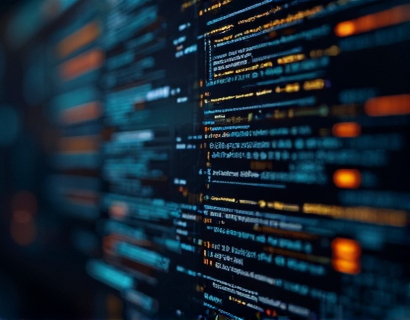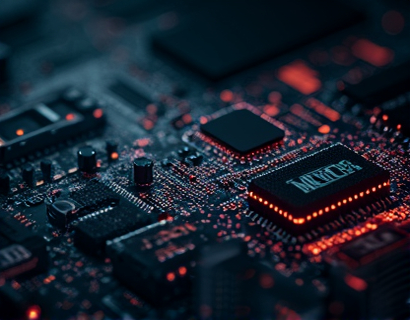Advanced Layer 2 Solutions: Transforming EVM-Enabled Blockchain Development for Scalability and Security
In the rapidly evolving landscape of blockchain technology, Layer 2 solutions have emerged as a pivotal advancement, particularly for EVM-enabled blockchains. These solutions are designed to enhance the scalability, security, and efficiency of blockchain networks, enabling the development of faster, more secure, and cost-effective decentralized applications. This article delves into the intricacies of advanced Layer 2 solutions and their transformative impact on EVM-based blockchain development.
Understanding Layer 2 Solutions
Layer 2 solutions refer to protocols and technologies built on top of the base blockchain (Layer 1) to improve transaction throughput and reduce costs. Unlike Layer 1 upgrades, which involve modifying the core blockchain protocol, Layer 2 solutions operate within the existing framework, providing a more agile and flexible approach to scaling. For EVM-based blockchains, such as Ethereum, Layer 2 solutions are crucial due to the inherent limitations of the base layer in handling high volumes of transactions efficiently.
Key Benefits of Advanced Layer 2 Solutions
Advanced Layer 2 solutions offer several key benefits that are essential for the future of blockchain development:
- Enhanced Scalability: By processing transactions off the main blockchain, Layer 2 solutions significantly increase the number of transactions a network can handle per second. This is particularly important for applications requiring high throughput, such as decentralized finance (DeFi) and non-fungible tokens (NFTs).
- Improved Security:
- Reduced Costs:
- Faster Transaction Times:
While Layer 2 solutions operate off the main chain, they maintain strong security guarantees by leveraging the underlying blockchain's consensus mechanisms. Advanced solutions employ techniques like state channels, sidechains, and rollups to ensure that transactions are secure and tamper-proof.
Transactions on Layer 2 are generally cheaper than on the main blockchain, making it more accessible for a broader range of applications and users. This cost reduction is achieved by minimizing the need for gas fees and computational resources on the base layer.
By offloading transactions to Layer 2, the time required for transaction confirmation is significantly reduced. This enhances user experience and supports real-time applications that require immediate transaction finality.
Types of Advanced Layer 2 Solutions
Several advanced Layer 2 solutions have been developed to address the specific needs of EVM-based blockchains:
State Channels
State channels allow multiple parties to conduct a series of transactions off the main blockchain, with the final state being submitted to the blockchain once the channel is closed. This method is highly efficient for applications with frequent, small transactions, such as gaming and micropayments.
Sidechains
Sidechains are separate blockchains that are linked to the main chain through bidirectional atomic swaps. They can operate with their own consensus mechanisms and rules, providing greater flexibility and scalability. Sidechains are useful for integrating external assets and protocols into the EVM ecosystem.
Rollups
Rollups are one of the most promising Layer 2 solutions for EVM-based blockchains. They bundle multiple transactions into a single transaction on the main chain, significantly reducing gas costs and increasing throughput. There are two main types of rollups:
- Optimistic Rollups: These assume that all transactions are valid and only challenge invalid transactions. They offer high throughput but require a challenge period to ensure validity.
- ZK Rollups (Zero-Knowledge Rollups): These use zero-knowledge proofs to bundle and verify transactions off-chain, providing faster finality and higher security. ZK Rollups are particularly well-suited for complex applications.
Implementing Advanced Layer 2 Solutions in EVM Development
For developers looking to leverage advanced Layer 2 solutions in EVM-based blockchain projects, several steps and considerations are essential:
First, it is crucial to understand the specific use case and the type of Layer 2 solution that best fits the application's requirements. For instance, state channels might be ideal for peer-to-peer transactions, while rollups are better for complex smart contract interactions.
Second, developers need to ensure compatibility with the chosen Layer 2 solution and the EVM ecosystem. This involves integrating the Layer 2 infrastructure with existing smart contracts and ensuring seamless interaction between on-chain and off-chain components.
Third, security is paramount. Developers must thoroughly test and audit the Layer 2 implementation to prevent vulnerabilities and ensure that the benefits of enhanced security are fully realized. This includes verifying the correctness of off-chain computations and the integrity of state transitions.
Tools and Frameworks
Several tools and frameworks facilitate the development of Layer 2 solutions for EVM-based blockchains:
- Plasma Framework: A popular framework for building state channels and other off-chain scaling solutions. It provides a robust set of tools for developers to create scalable and secure applications.
- Optimism: A platform that supports optimistic rollups, offering developers a user-friendly interface to build and deploy applications with high throughput and low costs.
- Arbitrum: Another leading platform for ZK Rollups, providing developers with the tools to create fast and secure decentralized applications on the Ethereum ecosystem.
Case Studies and Real-World Applications
The success of advanced Layer 2 solutions can be seen in various real-world applications:
One notable example is the use of Optimistic Rollups on Ethereum for decentralized finance protocols. Platforms like Synthetix and Yearn Finance have adopted rollup technology to handle a massive number of transactions with lower fees, enhancing user experience and accessibility.
In the NFT space, sidechains have been used to create more efficient marketplaces, reducing transaction costs and increasing the speed of asset transfers. This has opened up new opportunities for artists and collectors to engage with digital assets.
Future Prospects and Challenges
The future of advanced Layer 2 solutions for EVM-based blockchain development looks promising, with ongoing research and development addressing current challenges:
One major challenge is interoperability between different Layer 2 solutions and blockchains. Standardizing protocols and ensuring seamless cross-chain interactions will be crucial for the widespread adoption of Layer 2 technologies.
Another area of focus is improving the user experience for non-technical users. Simplifying the onboarding process and providing intuitive interfaces will help democratize access to Layer 2-enabled applications.
Additionally, the ecosystem must continue to evolve to support more complex use cases, such as cross-layer interactions and advanced governance mechanisms. Collaboration between developers, researchers, and industry stakeholders will be key to overcoming these challenges and unlocking the full potential of Layer 2 solutions.
In conclusion, advanced Layer 2 solutions are revolutionizing EVM-based blockchain development by addressing scalability, security, and efficiency concerns. By leveraging these technologies, developers can create faster, more secure, and cost-effective decentralized applications, driving the next wave of blockchain innovation.










































